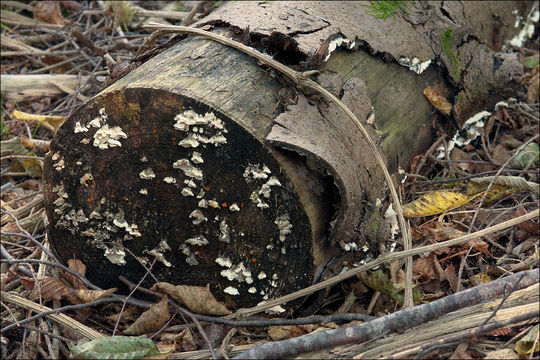صورة Skeletocutis amorpha (Fr.) Kotl. & Pouzar 1958

الوصف:
Slo.: brezlina kostenelka - syn.: Polyporus amorphus Fr. - Habitat: mixed wood, Picea abies, Ostrya carpinifolia and Fagus sylvatica dominant trees, moderately inclined mountain slope, southeast aspect; colluvial, calcareous, skeletal ground; relatively dry and warm place; in shade; partly protected from direct rain by tree canopies; average precipitations ~ 3.000 mm/year, average temperature 7-9 deg C, elevation 625 m (2.050 feet), alpine phytogeographical region. - Substratum: cutoff, partly debarked trunk of Picea abies lying on ground; on bark, on debarked wood and on laterally cut wood. - Comments: Growing on bark, on debarked wood, in between and on laterally cut wood in many fruit bodies, which were in resupinate, effuse-reflexed and pileate form; the resupinate form up to 12 x 6 cm in size, pilei confluent and up to 25 x 6(10) mm large; context duplex with a gelatinous layer above (very thin) tube layer and white cottony upper layer, all layers together 1.5 - 2.5 mm thick; fruitbodies soft, pliant when fresh and hard when dry; smell pleasant, mushroomy, slightly aromatic like perfumed soap, taste indistinctive (tasting on Picea bark); 5% KOH reaction on pore layer distinctly red, on pilei upper surface less pronounced, muddy orange-brown; SP very faint, probably whitish. - Comparing pictures in the literature and internet (pore layer color?), the find could also be similar and closely related Skeletocutis carneogrisea. However, the latter has somewhat smaller spores, is almost always resupinated (doesn't form pilei) and red KOH reaction is not reported (Ref.: 1). Since other traits fit well to literature I decided for Skeletocutis amorpha. - Spores smooth, allantoid. Dimensions: 3.8 [4.2 ; 4.4] 4.9 x 1.2 [1.4 ; 1.5] 1.7 microns; Q = 2.5 [2.9 ; 3.1] 3.4; N = 30; C = 95%; Me = 4.3 x 1.5 microns; Qe = 3. Generative hypha with clamps. Basidia dimensions: 12 [14 ; 15.5] 17.5 x 3.7 [4.3 ; 4.7] 5.3 microns; Q = 2.5 [3.1 ; 3.5] 4; N = 13; C = 95%; Me = 14.8 x 4.5 microns; Qe = 3.3. Olympus CH20, NEA 100x/1.25, magnification 1.000 x, oil (spores, basidia); NEA 40x/0.65, magnification 400x (hypha), in water, Congo red. AmScope MA500 digital camera. - Herbarium: Mycotheca and lichen herbarium (LJU-Li) of Slovenian Forestry Institute, Vena pot 2, Ljubljana, Index Herbariorum LJF - Ref.: (1) L. Ryvarden, R.L. Gilbertson, European Polypores, Part 2., Synopsis Fungorum 7., Fungiflora A/S (1994), p 621. (2) A. Bernicchia, S.P. Gorjon, Cortitiaceae s.l., Fungi Europaei Vol.12., Edizioni Candusso (2010), p 502. (3) G.J. Krieglsteiner (Hrsg.), Die Grosspilze Baden-Wrttembergs, Band 1., Ulmer (2000), p 577. (4) J. Breitenbach, F. Kraenzlin, Eds., Fungi of Switzerland, Vol.2. Verlag Mykologia (1986), p 290. (5) S. Buczacki, Collins Fungi Guide, Collins (2012), p 506. Nikon D700/Nikkor Micro 105mm/f2.8
مشمول على الصفحات التالية:
- Life
- Cellular
- Eukaryota (حقيقيات النوى)
- Opisthokonta
- Nucletmycea
- Fungi
- Dikarya
- Basidiomycota (دعاميات)
- Agaricomycetes (غاريقونانية)
- Polyporales (متعددات الأبواغ)
- Polyporaceae (دعريات)
- Skeletocutis
- Skeletocutis amorpha
هذه الصورة ليست واردة في أي مجموعات.
معلومات المصدر
- ترخيص
- cc-by-nc-sa-3.0
- حقوق النشر
- 2015 Dr. Amadej Trnkoczy
- مصور
- Dr. Amadej Trnkoczy
- النص الأصلي
- ملف الوسائط الأصلي
- زيارة المصدر
- موقع الشريك
- CalPhotos
- ID


